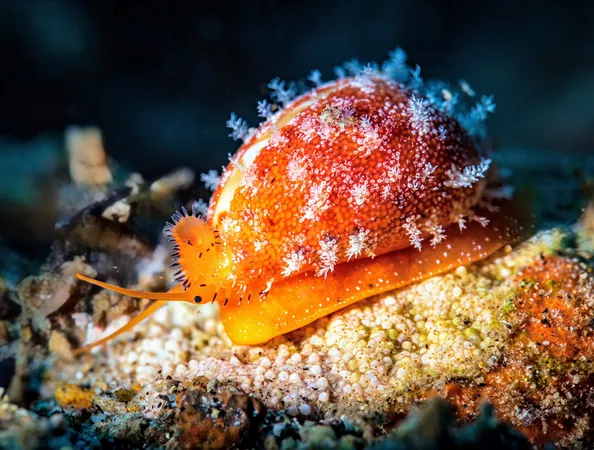
Meet Punk and Emo: Fossils That Challenge Everything We Knew About Mollusk Evolution!
2025-01-13
Author: Siti
Meet Punk and Emo: Fossils That Challenge Everything We Knew About Mollusk Evolution!
Paleontology has taken a sensational turn with the discovery of two fascinating fossils that are making waves in the scientific community: Punk and Emo! These 430-million-year-old relics are not just atypical fossils; they have forced scientists to rethink how we understand one of the most diverse groups of animals on our planet – the mollusks.
Discovering the Hidden Richness of Ancient Mollusks
Unearthed in Herefordshire, these specimens date back to the Silurian period and belong to the Aculifera group, traditionally seen as primitive organisms comprising chitons and worm-like mollusks. However, the recent findings suggest a much more complex story.
Lead researcher Dr. Mark Sutton from Imperial College London emphasizes the rarity of such well-preserved fossils. "We have created 'virtual fossils' – intricate 3D digital models that demonstrate an evolutionary richness previously unrecognized," he explained. This groundbreaking research reveals that the ancestors of Punk and Emo were far more advanced and varied than we had once assumed.
Introducing Punk and Emo: The Rockstars of the Fossil World
The distinct names Punk ferox and Emo vorticaudum were coined to reflect the unique characteristics of these ancient mollusks. Punk stands out with its edgy spiky exterior, reminiscent of a rebellious punk rocker, while Emo is recognized for its elongated, curled posture, evoking the identity of the emo culture. These names wonderfully capture the essence of early mollusks and highlight their remarkable features, which set them apart in the annals of evolutionary history.
Unraveling the Mysteries of Mollusk Movement
Through advanced imaging techniques like X-ray scanning, researchers scrutinized the delicate features of Punk and Emo without causing damage. This meticulous approach allowed scientists to generate high-resolution 3D models that uncovered astonishing insights into their living habits.
Emo likely moved akin to an inchworm, utilizing its spines to grip surfaces and push itself forward rhythmically. On the other hand, Punk remains a mystery in terms of movement, although its unique combination of a ridge-like foot and gills suggests it had a distinct way of traversing its environment, unlike any modern-day mollusk.
Shattering Traditional Classifications
Punk and Emo reveal a fascinating array of characteristics that defy traditional mollusk classifications. Punk, blending traits from multiple groups, showcases spiny, worm-like features alongside a broad foot and gills – traits commonly associated with chitons. Emo displays a spiny and elongated body but stands out with its unique adaptations that further blur the lines between established mollusk categories.
These findings illustrate that early mollusks were not only diverse but also showcased intricate evolutionary adaptations, challenging everything we thought we knew about their lineage. Dr. Sutton remarks, "This branch of molluskan evolution was far more intricate and diverse than we ever imagined."
A New Dawn for Mollusk Evolution
The research surrounding Punk and Emo is poised to transform our understanding of mollusk evolution over millions of years. By reassessing knowledge about the group Aculifera, scientists are uncovering a vibrant tapestry of evolutionary adaptations that allowed these ancient beings to thrive in their environments.
The study showcases that even seemingly simple organisms possess deep, complex evolutionary stories waiting to be revealed. With the aid of advanced technologies, the paleontological community is on the brink of discovering even more revelations that could reshape our understanding of the life forms that roamed our planet eons ago.
Stay tuned for further updates as the world of paleontology continues to unravel the secrets of the past! The groundbreaking findings are published in the journal Nature, and the excitement isn't over yet! Who knows what other ancient rockstars are waiting to be discovered?

 Brasil (PT)
Brasil (PT)
 Canada (EN)
Canada (EN)
 Chile (ES)
Chile (ES)
 Česko (CS)
Česko (CS)
 대한민국 (KO)
대한민국 (KO)
 España (ES)
España (ES)
 France (FR)
France (FR)
 Hong Kong (EN)
Hong Kong (EN)
 Italia (IT)
Italia (IT)
 日本 (JA)
日本 (JA)
 Magyarország (HU)
Magyarország (HU)
 Norge (NO)
Norge (NO)
 Polska (PL)
Polska (PL)
 Schweiz (DE)
Schweiz (DE)
 Singapore (EN)
Singapore (EN)
 Sverige (SV)
Sverige (SV)
 Suomi (FI)
Suomi (FI)
 Türkiye (TR)
Türkiye (TR)
 الإمارات العربية المتحدة (AR)
الإمارات العربية المتحدة (AR)